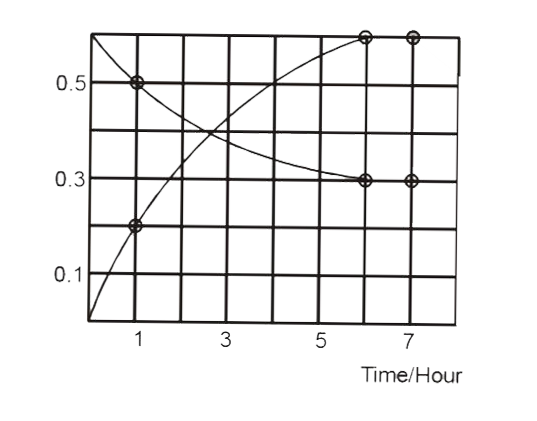The progress of the reaction A⇔nB, with times is presented in the figure below.

Determine:
(a) The value of n , (b) Keq
( c) Initial rate of converison of A
In the given time of 4hr (1 to 5), concentration of A falls form 0.5 to 0.3M, while in the same time concentration of B increases form 0.2 to 0.6M. The increase in the concentration of B in a given time s twice the decrease in the concentration of A.
(a) Thus, n=2
(b) [Beq]2[A]eq=(0.6)20.3=1.2
( c) Initial rate of converison of A=0.6−0.51−0=0.1Mhr−1
Topper's Solved these Questions
- CHEMICAL KINETICSBOOK - CENGAGE CHEMISTRYCHAPTER - CHEMICAL KINETICSEXERCISE - Ex 4.1 (Objective)
9 Videos
- CHEMICAL KINETICSBOOK - CENGAGE CHEMISTRYCHAPTER - CHEMICAL KINETICSEXERCISE - Ex 4.2 (Objective)
10 Videos
- CHEMICAL KINETICSBOOK - CENGAGE CHEMISTRYCHAPTER - CHEMICAL KINETICSEXERCISE - Archives Subjective
23 Videos
- CARBOXYLIC ACIDS AND THEIR DERIVATIVESBOOK - CENGAGE CHEMISTRYCHAPTER - CARBOXYLIC ACIDS AND THEIR DERIVATIVESEXERCISE - Exercises Archives (Analytical And Descriptive)
34 Videos
- COORDINATION COMPOUNDSBOOK - CENGAGE CHEMISTRYCHAPTER - COORDINATION COMPOUNDSEXERCISE - Archives Subjective
18 Videos
Similar Questions
Knowledge Check
The process of the reaction A⇔nB with time is represented in the fig, given below

The value of n isA1B2C3D1.5The rate law for reaction A+2B⇔C+2D will be :
ARate = K[A][B]BRate =K[A][2B]CRate = K[A][B]2DRate =[C][D]2[A][B]2With respect to the equilibrium reaction A⇔B. Which of the following graphs indicate the highest Kc value ?
A B
B C
C D
D
The progress of the reaction A⇔nB with time, is presented in figure. Determine

the equilibrium constant K.
View SolutionThe progress of the reaction A⇔nB with time is persented in the figure given below:

Determine
a. The value of n.
b. The equilibrium constant K.
c. The initial rate of concentration of A.
View SolutionThe progress of the reaction A⇔nB with time, is presented in figure. Determine

the initial rate of conversion of A.
View SolutionThe progress of the reaction, A ⇌ nB with time, is presented in figure given below. Determine.

(i) The value of n,
(ii) The equilibrium constant K, and
(iii) the initial rate of conversion of A.
View SolutionKp for the reaction A⇔B is 4. If initially only A is present then what will be the partial pressure of B after equilibrium ?
View Solution

